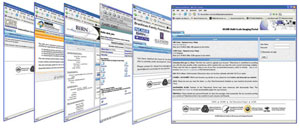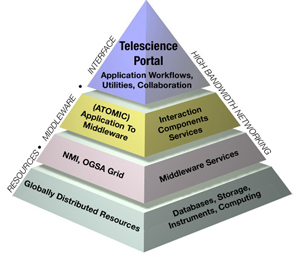From Microscopes to Middleware: The Telescience Project
San Diego, CA, August 6, 2006 -- One of the applications driving the Calit2-led OptIPuter project is biomedical imaging, specifically sharing and collaborating on very large data sets of brain images, among researchers thousands of miles apart. The work builds on long-standing expertise on the UCSD campus, where both the National Center for Microscopy and Imaging Research (NCMIR) and Biomedical Informatics Research Network (BIRN) are based, and where the Telescience™ Project started over a decade ago as an effort to make rare scientific instruments globally accessible.
 3D tomographic reconstruction of a Node of Ranvier. Image Courtesy: NCMIR |
 Telescience supports a number of scientific projects. Image Courtesy: NCMIR |
During the evolution of telemicroscopy, it became clear that remotely acquiring data wasn't enough for a complete remote research scenario. Data acquisition had to be closely coupled to data computation, data storage and meta-data management resources. Thus the Telescience Project was born, with a mandate to develop a grid-based architecture for end-to-end scientific research applications. Today, the Telescience Project focuses on minimizing the time required to create a grid-enabled scientific application.
"We have found that the most rate-limiting step in creating grid-based environments for scientific processes is not the deployment of the grid software stack, but rather the speed at which we can grid-enable and integrate existing domain applications," says Steven Peltier, NCMIR Executive Director.
|
To aid in this process, Telescience has created the Applications to Middleware Interaction Components. ATOMIC services aid scientific application developers by bundling the heterogeneous middleware components into functional themes with simplified service-based application programming interfaces. Telescience researchers have also been working closely with collaborators at the Information Sciences Institute and the University of Southern California to utilize workflow and planning technologies that aid in the parallelization of complex algorithms.
Together, these tools have already begun to dramatically decrease the effective time-to-grid for applications and advanced algorithms. Simple interactions, such as user registration or batch job launching, can now be added to applications in minutes. Where it used to take several months to parallelize and grid-enable an advanced mathematical algorithm, it can now be achieved in a just a couple of weeks using Telescience tools.
This Telescience "fabric" now supports a number of distributed and collaborative projects, including the Multi-Scale Imaging Project for the NCMIR, BIRN, the Environmental Health Science Data Resource Portal for the National Institute of Environmental Health Science, and most recently the National Brain Cancer Model Collaborative Network for the National Cancer Institute.
Learn more about the Telescience™ Project in the IBM Grid developerWorks® series. [This article appeared originally in Science Grid This Week.]
Related Links
Telescience Project
National Center for Microscopy and Imaging Research
Science Grid This Week

